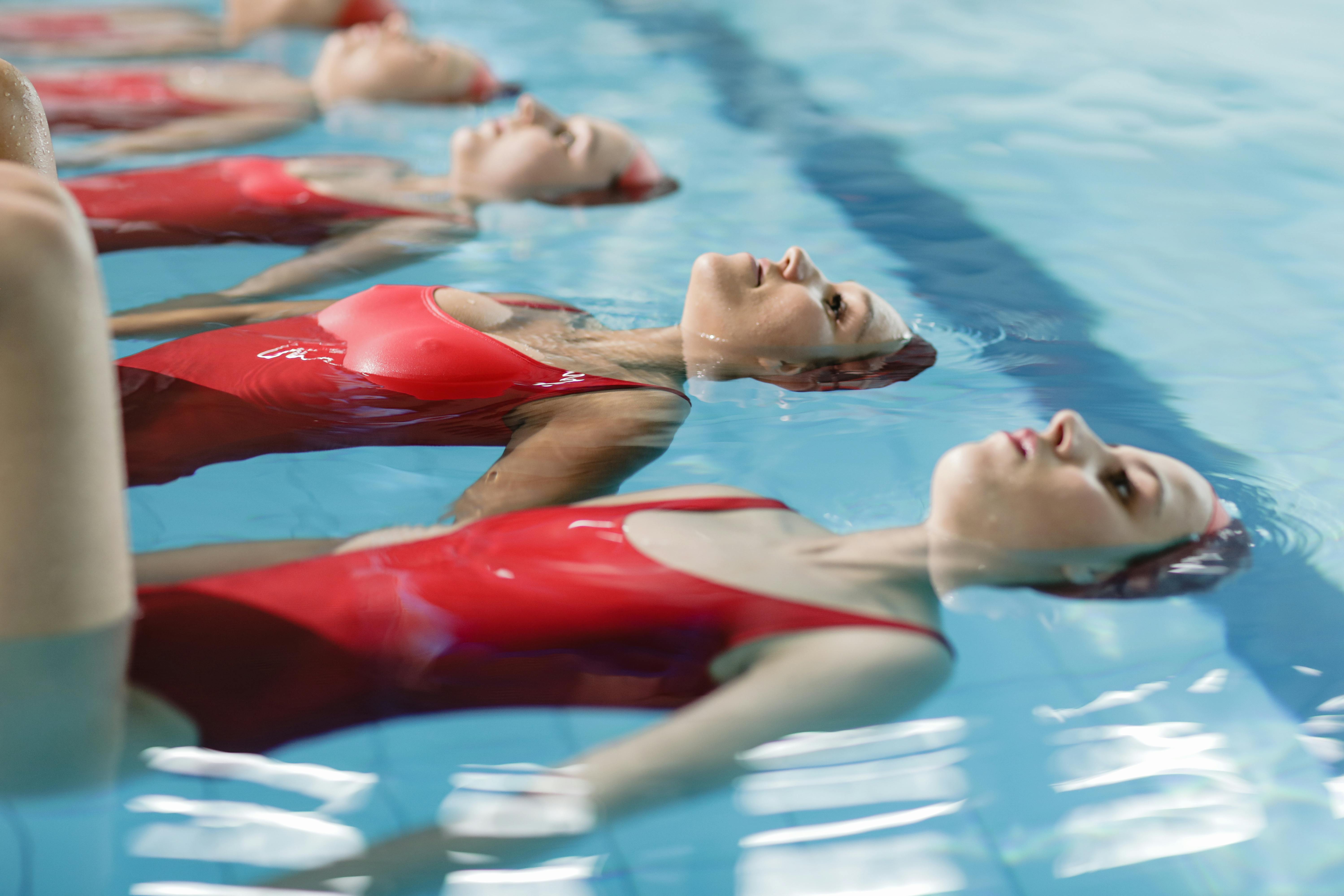Synchronized Swimming: The Aquatic Ballet Redefining Athletic Artistry
Synchronized swimming, a captivating blend of athleticism and artistry, has long been misunderstood and underappreciated in the world of competitive sports. This underwater dance, combining elements of swimming, gymnastics, and dance, pushes the boundaries of human endurance and creativity. As we dive deeper into this mesmerizing discipline, we'll explore its rich history, intricate techniques, and the incredible physical demands placed on its practitioners.

The Origins of Synchronized Swimming
Synchronized swimming’s roots can be traced back to the early 20th century, evolving from water ballets and ornamental swimming demonstrations. The sport gained popularity in the 1920s and 1930s, with early pioneers like Australian Annette Kellerman and American Katherine Curtis laying the groundwork for what would become a competitive discipline.
Initially, synchronized swimming was primarily a form of entertainment, featured in aquatic shows and Hollywood films. It wasn’t until the 1940s that it began to transition into a competitive sport. The first National Amateur Athletic Union (AAU) synchronized swimming competition was held in Chicago in 1939, marking a significant milestone in the sport’s development.
As the sport grew, so did its complexity and athletic demands. The International Swimming Federation (FINA) recognized synchronized swimming as an official discipline in 1952, paving the way for its inclusion in major international competitions.
Technical Mastery: The Building Blocks of Synchronized Swimming
At the heart of synchronized swimming lies a set of fundamental skills that athletes must master. These include precise swimming techniques, breath control, and a deep understanding of aquatic movement principles.
One of the most crucial skills is the eggbeater kick, a leg movement that allows swimmers to maintain a stable vertical position in the water. This technique provides the foundation for many of the sport’s impressive lifts and formations. Swimmers must also perfect various sculling techniques, using their hands to create propulsion and maintain balance in the water.
Breath control is another critical aspect of synchronized swimming. Athletes often hold their breath for extended periods, sometimes up to three minutes, while performing intricate underwater movements. This requires not only physical conditioning but also mental fortitude and relaxation techniques.
The sport also demands exceptional flexibility, particularly in the back, hips, and shoulders. Swimmers must be able to contort their bodies into various positions while maintaining proper form and alignment in the water.
Choreography and Artistic Expression
While the technical elements form the backbone of synchronized swimming, it’s the artistic components that truly set it apart. Routines are carefully choreographed to music, with movements designed to tell a story or evoke specific emotions.
Choreographers in synchronized swimming face unique challenges. They must create routines that are visually stunning both above and below the water’s surface, considering factors such as water resistance, buoyancy, and the limitations of underwater visibility.
Music selection plays a crucial role in the overall performance. The choice of music can greatly influence the mood and energy of a routine, and swimmers must synchronize their movements precisely to the rhythm and tempo of the chosen piece.
Costumes and makeup are also important elements of artistic expression in synchronized swimming. Waterproof makeup is meticulously applied to enhance facial expressions, while costumes are designed to be both aesthetically pleasing and functional in the water.
Physical Demands and Training Regimens
The physical demands of synchronized swimming are often underestimated. Athletes in this sport require a unique combination of strength, endurance, flexibility, and cardiovascular fitness.
Training regimens for synchronized swimmers are intense and varied. In addition to spending hours in the pool perfecting routines and techniques, athletes engage in a wide range of dry-land exercises. These may include strength training, yoga, dance classes, and gymnastics to improve overall body control and flexibility.
Cardiovascular conditioning is crucial, as routines can last up to four minutes and require sustained high-intensity effort. Swimmers often incorporate interval training and endurance swimming into their workouts to build the necessary stamina.
Mental preparation is equally important. Synchronized swimmers must develop exceptional focus and concentration to maintain precise timing and coordination with their teammates. Visualization techniques and mindfulness practices are often incorporated into training programs to enhance mental acuity.
Competitions and Judging Criteria
Synchronized swimming competitions are divided into several categories, including solo, duet, mixed duet, and team events. Each category has its own set of rules and judging criteria, but all are evaluated based on technical merit and artistic impression.
Technical merit encompasses the execution of required elements, such as specific figures or movements, as well as the overall synchronization of the swimmers. Judges look for precision, height out of the water, and the difficulty of the moves performed.
Artistic impression evaluates the choreography, interpretation of the music, and overall presentation of the routine. This includes factors such as creativity, use of space in the pool, and the emotional impact of the performance.
International competitions, such as the World Aquatics Championships and the Olympic Games, showcase the highest level of synchronized swimming. The sport has been part of the Olympic program since 1984, with various events being added or modified over the years.
The Evolution of Mixed-Gender Competition
One of the most significant recent developments in synchronized swimming has been the introduction of mixed-gender events. Traditionally a female-dominated sport, synchronized swimming has begun to embrace male participation at the highest levels of competition.
FINA introduced mixed duets at the 2015 World Aquatics Championships, marking a historic moment for the sport. This inclusion has not only expanded opportunities for male athletes but has also brought new dynamics and possibilities to choreography and performance.
The integration of male swimmers has led to innovations in lifts and throws, allowing for more spectacular aerial maneuvers. It has also challenged choreographers to explore new ways of expressing gender dynamics and relationships through movement in the water.
While mixed-gender events are still in their early stages, they represent an exciting direction for the future of synchronized swimming. As more countries develop mixed-gender programs, the level of competition and creativity in these events is expected to rise dramatically.
Technological Advancements in Training and Performance
As with many sports, technology has begun to play an increasingly important role in synchronized swimming. Advanced underwater cameras and motion tracking systems are now used to analyze swimmers’ movements with unprecedented detail.
Coaches can use this technology to identify areas for improvement in technique and synchronization that may not be visible to the naked eye. This data-driven approach to training has allowed athletes to refine their movements with greater precision than ever before.
Virtual reality (VR) technology is also being explored as a training tool. VR simulations can allow swimmers to practice routines and visualize performances in a controlled environment, potentially reducing the physical strain of constant in-water training.
In competition, underwater speakers have become standard, allowing swimmers to hear the music clearly while submerged. This technology has greatly improved the synchronization of movements to music, enhancing the overall quality of performances.
The Role of Synchronized Swimming in Aquatic Therapy
Beyond its competitive aspects, synchronized swimming has found applications in the field of aquatic therapy. The low-impact nature of water-based exercises, combined with the focus on body control and breath work, makes synchronized swimming techniques valuable for rehabilitation and fitness programs.
Aquatic therapists have adapted elements of synchronized swimming to help patients with various conditions, including arthritis, back pain, and neurological disorders. The buoyancy of water reduces stress on joints while providing resistance for strength training, making it an ideal environment for gentle yet effective exercise.
The breath control techniques used in synchronized swimming can be particularly beneficial for individuals with respiratory issues. Learning to regulate breathing and hold the breath for extended periods can improve lung capacity and overall respiratory function.
Furthermore, the artistic and creative aspects of synchronized swimming can provide psychological benefits, offering a form of expression and stress relief for participants in therapeutic programs.
Challenges and Future Prospects
Despite its unique blend of athleticism and artistry, synchronized swimming faces several challenges in terms of popularity and recognition. The sport often struggles to attract mainstream attention outside of major international competitions, and funding for programs can be limited in many countries.
One of the primary challenges is overcoming public perceptions of the sport. Many still view synchronized swimming as a purely aesthetic pursuit rather than a demanding athletic discipline. Educating the public about the physical and mental challenges involved in the sport is crucial for gaining wider recognition and respect.
Another issue is the accessibility of facilities and training programs. Synchronized swimming requires specialized pool space and equipment, which can be difficult to secure, especially in areas with limited aquatic resources.
However, the future of synchronized swimming looks promising. The introduction of mixed-gender events has opened up new possibilities for growth and innovation within the sport. There is also a growing interest in incorporating more diverse musical styles and cultural influences into routines, potentially broadening the sport’s appeal to a wider audience.
The Environmental Impact and Sustainability Efforts
As awareness of environmental issues grows, the world of synchronized swimming is also addressing its ecological footprint. Pool maintenance, water quality, and energy consumption are all areas where the sport is seeking to implement more sustainable practices.
Many facilities are now using advanced filtration systems and chemical-free water treatment methods to reduce the environmental impact of pool maintenance. Solar heating and energy-efficient pumps are being adopted to lower energy consumption.
There’s also a growing trend towards using eco-friendly materials in swimwear and accessories. Some manufacturers are developing suits made from recycled plastics or sustainable fabrics, addressing concerns about microplastic pollution from synthetic materials.
Furthermore, the sport’s governing bodies are encouraging the use of temporary pools for major events, which can be dismantled and reused, rather than building permanent facilities that may see limited use after competitions.
Cross-Training and Skill Transfer
The unique skill set developed by synchronized swimmers has led to interesting crossovers with other sports and disciplines. Many athletes find that their synchronized swimming background provides advantages in various aquatic and land-based activities.
For example, the core strength and body control developed in synchronized swimming translate well to activities like diving, gymnastics, and dance. The breath control techniques are valuable in sports like freediving and underwater hockey.
Conversely, synchronized swimming programs are increasingly incorporating elements from other disciplines to enhance training. Yoga and Pilates are often used to improve flexibility and core strength, while dance classes help refine artistic expression and musicality.
This cross-pollination of skills and training methods not only benefits the athletes but also contributes to the ongoing evolution of synchronized swimming as a sport.
The Psychology of Teamwork in Synchronized Swimming
One of the most fascinating aspects of synchronized swimming is the intense level of teamwork required. Unlike many team sports where individual performances can sometimes overshadow collective efforts, synchronized swimming demands absolute unity and coordination.
Psychologists have studied the unique dynamics of synchronized swimming teams, finding that they often develop extraordinarily strong bonds and a heightened sense of collective consciousness. The need to move in perfect unison, often while unable to see or communicate verbally with teammates, requires a level of trust and intuition that goes beyond typical team sports.
Coaches and sports psychologists working with synchronized swimming teams focus on developing strategies for building this deep connection. Techniques such as group meditation, trust-building exercises, and collective visualization are often employed to strengthen the team’s mental cohesion.
The psychological skills developed through synchronized swimming – such as the ability to perform under pressure, maintain focus for extended periods, and work in perfect harmony with others – are highly transferable to other areas of life, making the sport valuable for personal development beyond athletic achievement.
Nutritional Considerations for Synchronized Swimmers
The unique demands of synchronized swimming require a carefully tailored approach to nutrition. Athletes in this sport need to balance the need for strength and endurance with maintaining a physique that allows for graceful movement in the water.
Synchronized swimmers typically require a diet high in complex carbohydrates to fuel their long training sessions and provide sustained energy throughout performances. Protein intake is also crucial for muscle recovery and maintaining lean body mass.
Hydration is a particular concern, as athletes can easily become dehydrated during long pool sessions without realizing it. Many teams work with nutritionists to develop hydration strategies that include electrolyte-rich drinks and proper pre- and post-training fluid intake.
Timing of meals is also critical, especially on competition days. Athletes must balance the need for adequate fuel with avoiding discomfort during performances that involve frequent inversions and rapid movements.
Some synchronized swimmers also incorporate specific nutrients known to support lung function and oxygen utilization, such as nitrate-rich foods, to enhance their breath-holding capacity.
The Role of Music in Synchronized Swimming
Music is not just an accompaniment in synchronized swimming; it is an integral part of the performance that shapes every aspect of a routine. The choice of music can significantly impact the overall impression of a performance and often reflects cultural trends and artistic innovations in the sport.
Traditionally, classical music was the dominant choice for synchronized swimming routines. However, in recent years, there has been a shift towards more diverse musical selections, including pop, rock, electronic, and world music. This change has brought new energy and creativity to performances and has helped broaden the sport’s appeal.
The process of choosing music for a routine is complex and involves considerations of tempo, mood, and thematic elements. Choreographers and coaches often spend months selecting the perfect piece of music that will showcase their team’s strengths and convey the desired emotional impact.
Once the music is chosen, it undergoes a meticulous editing process. Sections may be cut, looped, or spliced together to create the perfect soundtrack for the routine. Underwater speakers are then used to ensure that swimmers can hear the music clearly throughout their performance, allowing for precise synchronization.
The relationship between movement and music in synchronized swimming is so intricate that many describe it as “making the music visible.” This unique interplay of sound and motion sets synchronized swimming apart as a true fusion of sport and art.
Technological Innovations in Costume Design
The costumes worn by synchronized swimmers are far more than just decorative attire; they are highly engineered garments designed to enhance performance while meeting strict competition regulations.
Recent years have seen significant advancements in the materials and construction techniques used for synchronized swimming costumes. High-tech fabrics that reduce drag in the water while maintaining opacity (a requirement in competition) are now standard.
Some teams are experimenting with costumes that incorporate LED lights or reflective materials, adding a new dimension to performances, especially in low-light or night-time exhibitions.
There’s also growing interest in using 3D printing technology to create custom-fitted costumes and accessories. This allows for intricate designs that would be difficult to achieve with traditional manufacturing methods, while also ensuring a perfect fit for each athlete.
As with other aspects of the sport, there’s an increasing focus on sustainability in costume design. Some manufacturers are developing suits made from recycled materials or exploring biodegradable options to reduce the environmental impact of competition wear.
The Global Landscape of Synchronized Swimming
While synchronized swimming has traditionally been dominated by a few powerhouse nations, particularly Russia, China, and Japan, the sport is experiencing growth and development in many parts of the world.
Countries like Spain, Italy, and Canada have made significant strides in recent years, challenging the established hierarchy. There’s also growing interest and investment in synchronized swimming programs in regions where the sport was previously less prominent, such as South America and parts of Africa.
The globalization of synchronized swimming has led to an interesting cross-pollination of styles and techniques. Teams from different countries often bring unique cultural elements to their performances, enriching the artistic diversity of the sport.
International exchanges and training camps have become more common, allowing athletes and coaches from different countries to share knowledge and experiences. This global collaboration is driving innovation in training methods, choreography, and performance techniques.
As the sport continues to evolve and attract participants from diverse backgrounds, it’s likely that we’ll see even more variety and creativity in synchronized swimming performances in the coming years.
The Future of Synchronized Swimming
As we look to the future, synchronized swimming stands at an exciting crossroads. The sport is poised for growth and innovation, with several trends shaping its trajectory.
One of the most significant developments is the continued expansion of mixed-gender events. As more countries develop programs for male swimmers and mixed duets, we can expect to see new dynamics and possibilities in choreography and performance.
Technology will likely play an increasingly important role, both in training and in enhancing the spectator experience. Virtual reality, motion capture technology, and advanced analytics tools may become standard in high-level training programs.
There’s also a growing interest in making synchronized swimming more accessible to a wider range of participants. Adaptive programs for swimmers with disabilities are being developed, opening up new opportunities for inclusion and diversity in the sport.
Environmental considerations are likely to become more prominent, with a focus on sustainable practices in pool maintenance, costume design, and event management.
As synchronized swimming continues to evolve, it remains a unique and captivating discipline that challenges our perceptions of what is possible in the water. By blending athletic prowess with artistic expression, it offers a spectacle unlike any other in the world of sports.
The future of synchronized swimming promises to be as dynamic and mesmerizing as the sport itself, with new innovations and achievements constantly pushing the boundaries of this aquatic art form. As it grows and adapts, synchronized swimming will undoubtedly continue to inspire and amaze audiences around the world, showcasing the extraordinary capabilities of the human body and spirit in the aquatic realm.





